Innovation in Shenzhen
Shenzhen is considered as a major innovation hub of the People's Republic of China (PRC). Over the years it has become one of the most important research and development (R&D) and manufacturing centers in the country.[1] In 2004, it was ranked by the Chinese Academy of Sciences (CAS) as the second most competitive city of China behind Shanghai.[2] It is also widely known as China's Silicon Valley and hosts several technology giants including DJI, Tencent and Huawei.[3]
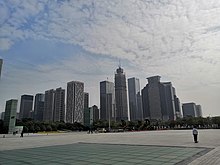
In the period from 2009 to 2014, private firms' share in Shenzhen's R&D was over 90% and Shenzhen's R&D budget as percentage of Gross Domestic Product (GDP) was 4.2% which was more than double the country's average and much above the 2.5% figure recognized as a threshold number for the innovative economies of the world.[4]
Located in the south of Guangdong province, forty years ago, Shenzhen was an impoverished, backward and deprived fishing village of China.[5] Since 1980, when Deng Xiaoping made it the first Special Economic Zone of PRC, Shenzhen has seen exponential growth.[6] Its GDP in 2017 was ranked fourth in China, just behind Shanghai, Beijing and Guangzhou.[6]. The economic transformation of the city is attributed to the bold economic experiment of Deng Xiaoping.[5] However, once the city broke the shackles of poverty and came out of its destitution, it was the extensive usage of science, technology and innovation that kept it moving on a steep trajectory of sustainable social and economic progress. Shenzhen Science and Technology Development Plan in this regard was issued in the 1980s.[7]
Through the years Shenzhen has also remained at the heart of the Shanzhai culture which has successfully copied and improved existing products and clearly depicts the entrepreneurial and industrious minds of its people.[8] A product that required one to one and a half year for a Western company to take it to the market could sometimes take only four to six weeks within the Shanzhai ecosystem.[9] Shenzhen also has a complete policy and legal system supportive of high-tech development.[10] There are several factors responsible for the development of Shenzhen as a highly successful innovation ecosystem in China.
Key success factors
Immigration
Shenzhen is regarded as the largest immigrant city in China.[4] “Shenzhen is a city built on migrant labour,” says Geoffrey Crothall, spokesman for the advocacy group China Labour Bulletin.[5] At the time of opening up, there was absence of advanced educational institutions and Shenzhen, therefore, reached outside for its talent needs to upgrade its innovative capacity.[10] Over the years, the city has witnessed a high influx of skilled manpower which has enhanced its innovative capacity.[4] Several policies attracting talented people like establishment of labour and personnel services companies, raising a human intelligent market and holding "talent meetings" were enforced.[1] As a result, talent-savvy people from China and various parts of the world moved to Shenzhen. Skilled migrants such as software development personnel with university degrees, professional people with mid to senior level positions and inventors of important inventions along with their families were permitted to settle down as registered residents in Shenzhen and were exempted from the infrastructure expansion fee of the city.[1] A reward system to recognize the contributions of outstanding talent was also put in place.[1] Shenzhen, therefore, became an attractive place for talents in engineering, science and technology who made conscious efforts to settle and work there.[11] Many of these settlers with the entrepreneurial spirit in them were responsible for setting up start-up companies in the city.[11]
Foreign firms and investments
Shenzhen has positioned itself as the entry point for foreign science and technology firms intending to initiate their businesses in China.[11] In the initial years after Deng's reforms, Multinational Companies (MNCs) established their manufacturing facilities there to leverage upon ample pool of relatively unskilled and inexpensive labour.[2] Later, preferential policies were put in place for encouraging foreign companies to invest in Shenzhen such as half the rate of corporate taxes in comparison to the domestic Chinese firms.[1] Foreign companies were also exempted from the 3% income tax.[1] As a result of preferential policies, Shenzhen became a successful center for assembly manufacturing for export.[2] As Shenzhen experienced economic growth, the costs of labour and infrastructure went up and its municipal government, therefore, recognized that it could no longer enjoy the advantage of a low-cost assembly center and started working for developing an innovation system for the city.[2]
Academic and research institutes
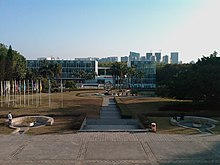
In 1979, just before the economic reforms, Shenzhen had no indigenous universities and research institutes.[2] The government recognized the importance of higher education and research for industrialization of the city and established Shenzhen University in 1983 and Shenzhen Polytechnic in 1993.[2] Subsequently, Peking University (PKU), CAS, Chinese Academy of Engineering (CAE) and Hong Kong University of Science and Technology (HKUST) also established research centers in Shenzhen.[2] Besides these, Beijing University, Tsinghua University (THU) and Central China University of Science and Technology also established research institutes or branches in Shenzhen.[10] The roots of Shenzhen’s movement to climb up in the value chain can be traced back to 1985 when its municipal government and CAS established Shenzhen Science and Technology Industrial Park[2]. Later in 1996, Shenzhen High-tech Industrial Park was established.[12] To further incentivize the research institutes and universities, the municipal government of Shenzhen also came up with the virtual campus concept in 2000 and offered free office space, infrastructure, computers, telephones and computer networks for the first two years of the projects.[2] These steps brought the desired results and Shenzhen developed its own Regional Innovation System (RIS).
Sustained economic growth
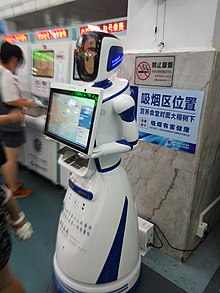
Till 1995, Shenzhen's GDP grew at an average rate of 35% annually and from 1995 to 2014 it maintained an annual growth rate of about 14%.[4] This enviable and sustained economic trajectory produced the required resources for upgrading Shenzhen's industrial base and transitioning it into a technology and innovation-driven economy. Shenzhen's manufacturing base transitioned into new-tech, high-tech and clean-tech and industries such as information technology, new energy, numerical control tools, robotics, new materials and biotechnology thrived.[4] For a sustained growth, the city has successfully diversified itself and instead of just hardware like hoverboards, sophisticated products combining hardware and software like just-in-time bookable electric scooters, app-controlled drones and artificial intelligence like translation devices, toy robots, semi-autonomous vehicles are being manufactured there.[9] A long period of economic growth, therefore, has allowed the city to invest in innovative activities and innovation in return has played a pivotal role in sustainable growth of Shenzhen. Finally, in 2018, for the first time, Shenzhen's GDP surpassed that of Hong Kong, one of the richest parts of China, when it reached the figure of 2.42 trillion Yuan.[13]
Notable innovative companies in Shenzhen
Huawei
Huawei is a global fortune 100 company; the largest telecommunications equipment manufacturer in the world and the second-largest smartphone manufacturer just behind Samsung.[14]
Tencent
Tencent is one of the biggest internet and technology companies of the world and also the biggest investment corporation.[14] It owns QQ which is a social media platform with 850 million monthly users and WeChat which has 963 million monthly users.[14]
Build Your Dreams
Build Your Dreams (BYD) owns BYD Automobiles and BYD Electronics with BYD Automobiles selling more than 500,000 passenger cars in China in 2013.[14] It is backed by Warren Buffett's investment firm and has a Joint Venture with Daimler AG.[14]
Beijing Genome Institute
Beijing Genome Institute (BGI) is the largest genome sequencing company in the world.[14] It has been reported that in 2014, BGI was producing 500 cloned pigs a year that were used to test new medicines.[14]
DJI
DJI is the world leader in Unmanned Aerial Vehicles (UAV) with a market share of 50-70% of the global consumer drone market.[14] It is estimated that in 2021, 4 million consumer drones from DJI will be in use across the world.[14]
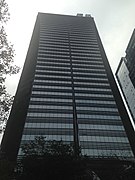 Headquarters of Tencent in Shenzhen
Headquarters of Tencent in Shenzhen Huawei P10 Smartphone
Huawei P10 Smartphone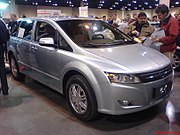 A BYD plug-in electric car
A BYD plug-in electric car Drone Mavic Pro by DJI
Drone Mavic Pro by DJI
References
- Zhihua Zeng, Douglas. "Building Engines for Growth and Competitiveness in China" (PDF). The World Bank. Retrieved 14 July 2020.
- Chen, Kun; Kenny, Martin (1 September 2005). "Universities/Research Institutes and Regional Innovation Systems: The Cases of Beijing and Shenzhen" (PDF) (BRIE Working Paper 168). doi:10.1016/j.worlddev.2006.05.013. Retrieved 14 July 2020. Cite journal requires
|journal=(help) - CNN, Matt Rivers. "Inside China's Silicon Valley: From copycats to innovation". CNN. Retrieved 13 July 2020.
- Chen, Xiangmin; Lynch Ogan, Taylor. "China's Emerging Silicon Valley: How and Why Has Shenzhen Become a Global Innovation Centre". Retrieved 14 July 2020.
- Sala, Ilaria Maria (10 May 2016). "Story of cities #39: Shenzhen – from rural village to the world's largest megalopolis". The Guardian. Retrieved 14 July 2020.
- "Shenzhen: A story of change - China - Chinadaily.com.cn". www.chinadaily.com.cn. Retrieved 14 July 2020.
- Johnson, Cathryn; Scott Davis, Lawrence. "THE STORY OF SHENZHEN" (PDF). metropolis.org. United Nations Human Settlements Programm. Retrieved 16 July 2020.
- "ShenZhen startup scene". Innovation Is Everywhere. 23 December 2014. Retrieved 13 July 2020.
- "Inside Shenzhen's race to outdo Silicon Valley". MIT Technology Review. Retrieved 16 July 2020.
- Lai, Hsien-che; Chiu, Yi-chia; Leu, Horng-der (1 September 2005). "Innovation capacity comparison of China's information technology industrial clusters: The case of Shanghai, Kunshan, Shenzhen and Dongguan". Technology Analysis & Strategic Management. 17 (3): 293–316. doi:10.1080/09537320500211284. ISSN 0953-7325. Retrieved 15 July 2020.
- "Shenzhen Then and Now: A Tale of Transformation". Medium. 21 February 2019. Retrieved 14 July 2020.
- Li, Ning (2000). "High-tech industrial zones: New impetus pushing economy up". Beijing Review. 17 (43): 12–20. Retrieved 15 July 2020.
- "China's tech hub Shenzhen set to hit 2019 growth target". South China Morning Post. 9 January 2020. Retrieved 16 July 2020.
- "5 Shenzhen Companies You Should Know - 1421 Consulting Group". 1421 Consulting Group. 27 August 2018. Retrieved 16 July 2020.